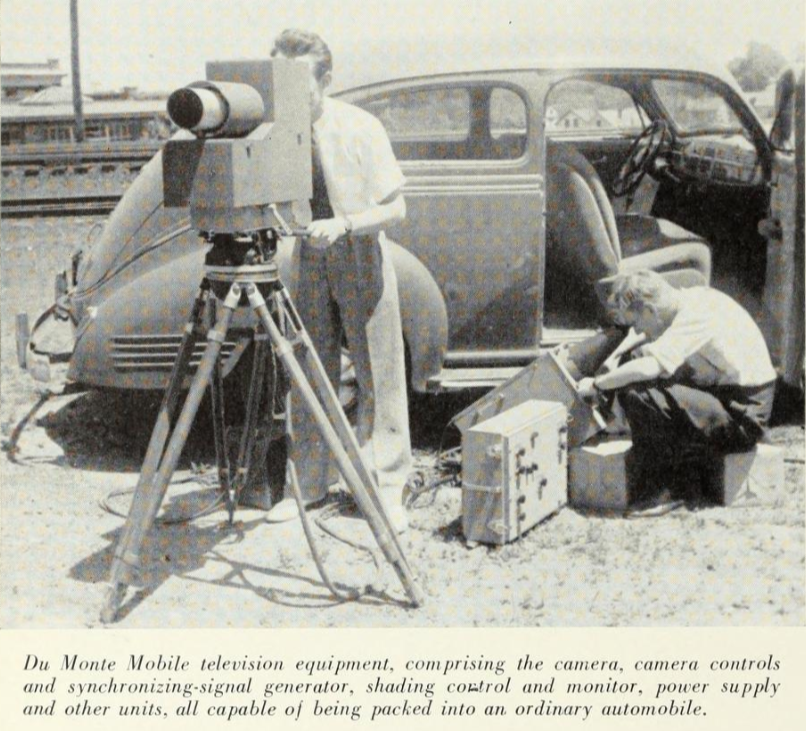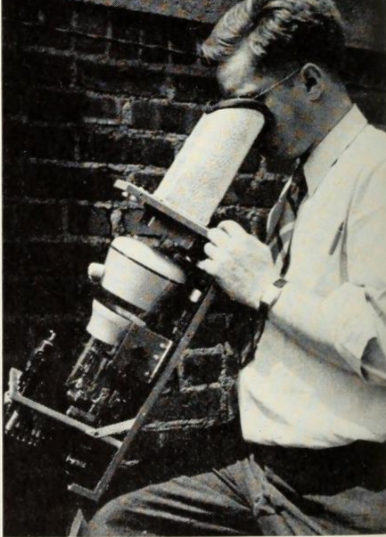The Birth Of The Camera Mounted Electronic Viewfinder
With all of RCA’s incredible advances and discoveries in television, you would have thought that they would be the ones to put an electronic viewfinder into a television camera, but no…they weren’t. The first production cameras made by RCA and DuMont used Iconoscope pickup tubes but RCA did not add an electronic viewfinder until the prototype versions of their Image Orthicon cameras. RCA had a second optical lens above the taking lens that fed and upside down optical image onto a ground glass plate inside the top of the camera. As you can see below, that could be pretty confusing to the cameraman. For more on the RCA camera click the link. https://eyesofageneration.com/some-little-known-facts-of-early-television-production-yesterday-i-posted-t/

What you will see here is what I believe to be, history in-the-making in this sequence of rare photos that would have been totally overlooked had Barry Mitchell not sent them to me.
I feel pretty sure that what we see here in the photo below, is the first ever image of DuMont’s Iconoscope camera. The DuMont prototype camera.
The photo is of a demonstration of how an electronic television broadcast can go mobile, without even a mobile unit. This photo is from the November 1941 issue of International Photographer Magazine (page 351).
With a setup and body style (https://www.earlytelevision.org/emi_emitron.html) very similar to the BBC’s prewar Emitron cameras, this DuMont prototype camera had only an optical sighting hole. Although you can’t see it here, in the third photo down, you can see a ground glass style viewfinder port on the rear, similar to the RCA style on their prewar iconoscope cameras.
Behind the camera operator is the engineer/utility man and notice that he is looking into an electronic viewfinder (with a veiwfinder hood no less). The photo was most likely taken on the DuMont plant grounds in Passaic N.J., just weeks before Pearl Harbor. As a side note on the date, at this same point in history, brand new NBC Studios 6A and 6B were nearing the end of construction and were being readied for radio broadcasts at 30 Rock.


Above is the viewfinder we see in the top photo with the “business end” out of the box. In the box, that is much bigger because of the power supply unit, only the accompanying engineer can see the image which is really not much help to the man behind the camera, but our photo journey continues.
Below is a photo from about a year later (1942 or ’43) that shows DuMont’s new mobile unit that was operated out of their offices and studios at 515 Madison Avenue. Remember, the top photos were taken a month before Pearl Harbor was bombed and shortly after, all electronics manufacturers efforts turned to the war effort…BUT. NBC/RCA, CBS and DuMont all had experimental television stations and DuMont’s W2XWV in New York continued to broadcast on Wednesday and Sunday nights for a few hours.
The image below is most likely from and early evening live broadcast in New York in the summer of 1943. This is most likely the same, single prototype iconoscope camera in the photo above, but notice now, VOILA! The electronic viewfinder is now mounted along the lower left side of the camera, with cords to it’s power supply in the truck in plain site. The next DuMont camera we see will not be this original prototype…it will be their production model that went into service around late 1945 or early ’46.

Below, we have a new casing for the camera and the viewfinder mounted at an angle up the left side for easy viewing and adjustment and in service at DuMont’s KTLA in Los Angeles. -Bobby Ellerbee
